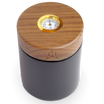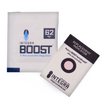Table of Contents
Introduction
Not all vaporizers are created equal—and in 2025, the difference between mechanical and electronic vaporizers is more important than ever. As cannabis use evolves, so does the technology surrounding it. But at the heart of every great session is this question: how do you want to interact with your plant?
Electronic vaporizers offer convenience, precision, and automation. Mechanical vaporizers offer durability, freedom, and ritual. Both have their place—but they serve fundamentally different purposes and appeal to different mindsets.
This guide explores what truly sets these two categories apart. From how they heat your herb to how they feel in your hand, we break down the science, the philosophy, and the experience—so you can choose the vaporizer that aligns with your lifestyle, not just your wishlist.
If you're new to manual vaporizers, you may also enjoy our blog post on Why Manual Vaporizers Are the Future.
What Is a Mechanical Vaporizer?
A mechanical vaporizer—also known as a manual or analog vaporizer—is a device that heats cannabis flower using an external flame, typically a small torch. It contains no battery, electronics, wires, or software. Instead, you control the heat in real time with your breath, flame, and technique.
How It Works:
- You manually heat the vaporizer’s thermal element (such as a cap or pan) using a torch or lighter
- Airflow is activated by your inhale, drawing hot air over the herb for vaporization
- Temperature control comes from distance, flame duration, and breath pacing
Key Features:
- No batteries, charging, or electronics
- Virtually indestructible with proper care
- Fully portable—works anywhere, anytime
- Minimal maintenance and long product life
Examples of mechanical vaporizers include the Vapman Click, Lotus Vaporizer, and DynaVap models. They’re perfect for people who enjoy analog simplicity, flavor precision, and a hands-on experience.
What Is an Electronic Vaporizer?
Electronic vaporizers use built-in batteries, circuit boards, and sensors to heat cannabis flower (or concentrate) at specific temperatures. They often feature preset modes, digital displays, and app controls to automate the session from start to finish.
How It Works:
- Internal battery powers a heating element or oven
- User selects a temperature or preset mode via button or app
- Device heats up automatically and vibrates or displays when ready
Key Features:
- Precise temperature control with minimal input
- Rechargeable battery—some last 5–10 sessions per charge
- Screen, LED, or app-based interface
- Usually larger and more complex to clean
Popular examples include the Pax Plus, Mighty+, DaVinci IQ2, and Arizer Solo 2. These are great for those who value set-it-and-forget-it convenience, built-in battery life, and digital precision—but they come with trade-offs in repairability, maintenance, and connection to the process.
Mechanical vs. Electronic: Key Differences
While both types of vaporizers serve the same goal—converting cannabis into inhalable vapor—the way they get there is fundamentally different. Here’s a breakdown of the key distinctions between mechanical and electronic vaporizers in 2025:
| Feature | Mechanical Vaporizers | Electronic Vaporizers |
|---|---|---|
| Heat Source | External flame (torch or lighter) | Internal battery-powered heating element |
| Temperature Control | Manual, based on flame and breath | Digital presets or precision display |
| Startup Time | 3–10 seconds (no preheat) | 30–90 seconds on average |
| Battery Dependency | None—works anytime, anywhere | Battery charge required; limits use |
| Flavor Quality | Exceptional—no electrical interference | Good to excellent—varies by model |
| Durability | High—fewer breakable parts | Moderate—batteries and screens degrade |
| Maintenance | Minimal—no firmware or ports | Moderate to high—regular charging and cleaning |
| Learning Curve | Moderate—requires practice | Low—plug and play |
| User Experience | Manual, intentional, ritualistic | Automated, convenient, tech-driven |
In short: mechanical vaporizers offer simplicity, long-term value, and a more engaging experience. Electronic vaporizers focus on automation, precision, and digital convenience—but at the cost of deeper user involvement.
Why More Users Are Switching to Mechanical
In a landscape flooded with high-tech gadgets, touchscreen controls, and frequent firmware updates, mechanical vaporizers are making a quiet but powerful comeback. Why? Because more users are prioritizing reliability, ritual, and flavor over automation and complexity.
1. No Batteries, No Stress
Mechanical vaporizers work every time—no charging, no dead batteries, no waiting. This makes them especially appealing to off-grid users, travelers, and those who simply want to inhale without worrying about electronics.
2. More Flavor, Less Interference
Without circuit boards, heating elements, or internal fans, mechanical vapes deliver unfiltered vapor flavor. Devices like the Lotus and Vapman are specifically praised for their ability to preserve terpene richness with surgical control.
3. Built to Last
Mechanical devices have fewer parts that can fail. There's no planned obsolescence, no lithium battery to degrade, and no app compatibility to worry about. Many units last for years—and look better with age.
4. Encourages Ritual
Instead of tapping a button and zoning out, mechanical vapes draw you into the moment. You light, you pace your breath, you watch the vapor form. It’s mindful, deliberate, and deeply satisfying.
5. Lower Cost Over Time
While upfront prices may be similar, mechanical vaporizers save you money over time. No replacement batteries, no software breakdowns, no costly repairs. Just clean, flame-powered function that lasts.
This shift toward simplicity reflects a broader trend: users wanting deeper, cleaner, and more conscious cannabis sessions. The more you use mechanical, the more electronic starts to feel—unnecessary.
Which One Is Right for You?
Ultimately, both mechanical and electronic vaporizers serve different needs—and the right choice depends on how you like to consume, what you prioritize, and what kind of experience you want.
Choose a Mechanical Vaporizer If You:
- Enjoy ritual, breath control, and analog simplicity
- Want a durable, battery-free device that works anywhere
- Prioritize vapor flavor, responsiveness, and long-term value
- Don’t mind learning a new skill and refining your technique
Choose an Electronic Vaporizer If You:
- Prefer set-it-and-forget-it convenience
- Need digital precision or medical consistency
- Use cannabis in session-style formats with preheating
- Want integrated displays, dosing apps, and fast button-start
There’s no wrong answer—but knowing the pros and trade-offs helps you commit to a style that fits your lifestyle. Some users even keep both: a mechanical device for everyday ritual, and an electric one for social use or travel.
Conclusion
Mechanical and electronic vaporizers each have their strengths. But in 2025, more users are leaning toward the simplicity, reliability, and flavor that mechanical models provide. No batteries. No firmware. Just breath, flame, and plant—on your terms.
Whether you want the quiet, microdosing elegance of the Vapman or the bold convection power of the Lotus, mechanical vaporizers let you inhale with intention. You’re not pressing buttons—you’re crafting a session. And that difference is more than technical. It’s transformational.
If you’re tired of chasing the next app-controlled upgrade or dealing with battery anxiety, maybe it’s time to simplify—and reconnect. Your lungs (and your ritual) will thank you.
About the Author

Author: Michael Mussner, Founder of INHALE Vaporizers
Michael is a passionate vaporizer designer and entrepreneur from South Tyrol, driven by craftsmanship, sustainability, and the mindful use of natural herbs. With a background in product innovation and a love for analog technology, he founded INHALE to revive flame-powered vaporizers like the Vapman and Lotus. Every product he creates is deeply rooted in authenticity, simplicity, and a respect for nature.
Questions? Contact us here or email support@nowinhale.com.

















Leave a comment
All comments are moderated before being published.
This site is protected by hCaptcha and the hCaptcha Privacy Policy and Terms of Service apply.